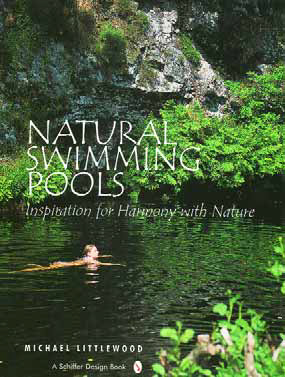A Natural Transition

Did you know that there’s a strong trend toward creating ponds that are made for swimming in Germany and Austria? That revelation came by way of a terrific book I just finished – Natural Swimming Pools: Inspiration for Harmony with Nature by Michael Littlewood (Schiffer Publishing, 2004).
Littlewood is an American landscape designer who moved to Europe several years ago and has since become involved in the design and installation of naturalistic watershapes that are a distinct departure from run-of-the-mill concrete pools we encounter in the United States.
Indeed, he and scores of other watershapers throughout Europe are setting up vinyl-lined ponds that lack most of what we’d recognize as pool features or equipment, but are deep enough and big enough for swimming and other forms of aquatic exercise. And the simple fact is that their European clients seem inclined to jump into these interesting vessels with both feet.
The 250-page text is richly illustrated and if nothing else is a terrific idea book. It covers a variety of large ponds across a range of settings – including several commercial installations, which is something that’s difficult to imagine in the United States, given the nature of standards and the involvement of health departments in such projects here.
I also found that many of the aesthetic ideas on display in these pond applications can readily be translated to concrete swimming pools, so even if you’re not into ponds at this point, the images Littlewood presents are of real interest to designers in search of inspiration. There are wonderful examples of all sorts of edge and landscape treatments as well as brilliant uses of aquatic plants and rockwork.
One of the big themes carried within the text has to do with natural water treatment: None of the systems depicted is dosed with chemical additives such as chlorine and muriatic acid, and the author gives offers substantial, substantive examples of how these systems are kept safe and enjoyable by way of natural filtration from gravel beds and the root systems of aquatic plants. There’s very little mention of separate filtration and only scant information about circulation systems.
On that level, the book is more of an advocacy piece rather than any kind of technical discussion, and it’s clear in the text that in Europe (at least), the “green” value system has caught on in a big way.
It’s also clear that expectations for water quality there are different than they are here at home, where everything is expected to be pristine and clear all the times. Based on the text and several of the images, it’s obvious that Europeans are not terribly fussy when it comes to a bit of algae here and there.
The notion of building ponds for swimming is not entirely alien to us in the United States, but it’s certainly not a concept that stands at the forefront of design trends, either. Nonetheless, this book caught my eye because I know that ideas that rise in other countries (Europe in particular) tend to migrate to the U.S. marketplace in time – and I know it won’t be all that long before I’m asked about “swimming ponds” by my world-traveling design clients.
This slim volume may not be the last word in technical or practical terms, but it’s certainly an eye-opener that has prepared me to understand and appreciate ponds in which my clients might want to swim and play.
Mike Farley is a landscape designer with more than 20 years of experience and is currently a designer/project manager for Claffey Pools in Southlake, Texas. A graduate of Genesis 3’s Level I Design School, he holds a degree in landscape architecture from Texas Tech University and has worked as a watershaper in both California and Texas.











